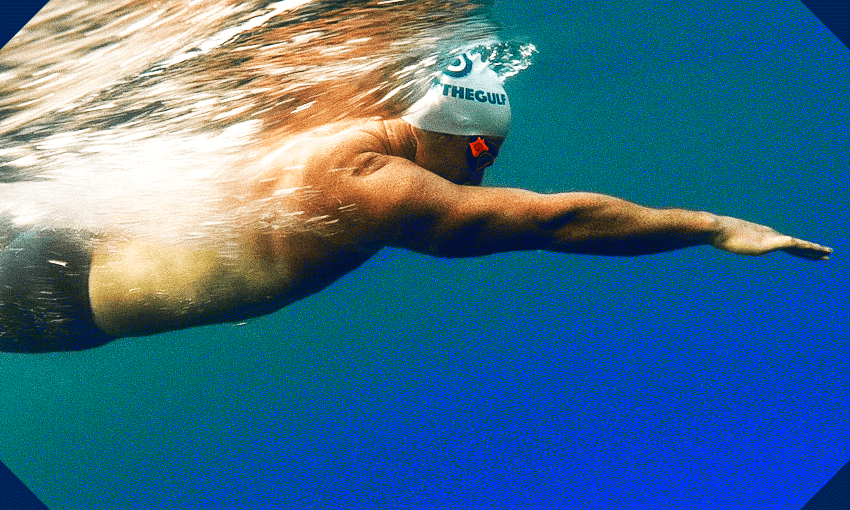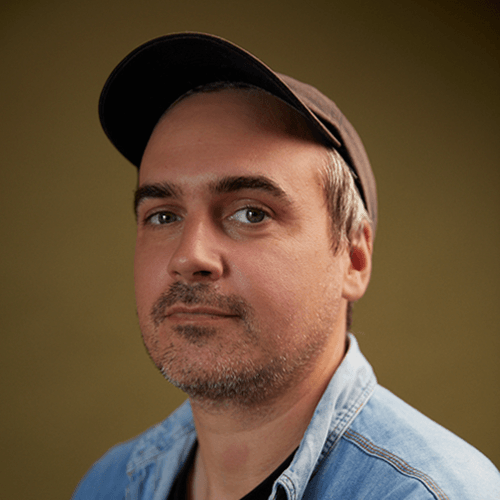Alex Casey talks to ultramarathon swimmer Jono Ridler about exactly what happens when you swim in the sea for nearly two days straight – and why he put himself through it.
As Jono Ridler ploughed through the water on the second night of his ultramarathon swim, he caught a glimpse of something strange in the darkness of the Hauraki Gulf. On the nearby support boat, a snowman and a giant potato stood side by side. Then, around him, picture frames and solar panels began to bob on the surface of the sea. When he peered below, the ocean floor gleamed with luxurious courtyard tiling. Drawing on his already-dwindling energy reserves, his voice rang through the night air: “Are you guys real?”
“At that stage it was definitely getting harder to determine exactly what was going on,” Ridler laughs over Zoom, safely back on dry land. “I’ve never had hallucinations before but I’ve also never stayed awake for that period of time before.” When the snowman appeared, Ridler had been awake for 36 hours, most of them spent attempting to swim 100km between Great Barrier Island and Auckland. He was exhausted and hypothermic, battling 30 knot winds and two metre swells that threatened to bring his new fantasy friends crashing down on him.
The first question, of course, is why do it? Ridler first got into open water swimming in his early 20s after completing a swim across Auckland Harbour. “I’ve always had a bit of a leaning for endurance activities, and just wanting to see what I can do with my body and my mind,” he explains. “What is really compelling for me is just that sense of adventure and total lack of limitations – just being able to go as far as you want to go, or as far as you can go.” The swims got longer, the obsession grew, and eventually he settled on his next big 100km goal.
As well as a distance goal, the swim needed a purpose. Given he has spent a decade in the proverbial drink, Ridler has watched the health of the ocean plummet in front of his eyes. “I definitely notice how cloudy it is, it’s very different to a healthy ocean where the water is really clear.” Then there’s the sewage overflow, the dearth of fish eggs, and the heaving kina barrens. “Kina don’t have the predators to keep them in check anymore,” he says, explaining that crayfish are basically extinct in the Gulf and snapper are always “wiped out” through overfishing.
Partnering with conservation charity Live Ocean, Ridler got to work preparing to swim the equivalent of the distance from Auckland to Huntly. He swam for at least eight hours every Saturday and Sunday for months, back and forth down Takapuna beach. “I swam at night pretty often too. So either through the night, or starting really early in the morning. I’d also go out at night after work – go home, get my liquid feeds together, drive out to Takapuna, swim overnight, and come back early in the morning.” When the weather wasn’t playing ball, it was eight hours in the pool.
After months of intensive training, Ridler took the plunge in late April. The final meal on land was cooked oats and beetroot juice (slow release carbs and natural performance-enhancing nitrates) while he went over the plans one more time with his crew. With a support team including two medics, multiple “feeders”, videographers and skippers for the support vessels, this was hardly a quick dip at Herne Bay. He was then slathered in nappy rash cream, lanolin and petroleum jelly for chafing and warmth – marathon rules state no wetsuits allowed.
Once he began swimming, Ridler would periodically be fed by the support team, who would biff a bottle of some delightful sounding “hot liquid feed” using a rope and carabiner in his direction. “I would chug it down, they might say a few words, I might say a few words back and then I’m back on my way.” Alas, the feeding plan had to be thrown out on the first day, as Ridler encountered some debilitating “gut distress” that caused severe pain. Once he got through it, he asked if he could have some of the support crew’s dinner (meatballs) instead. They obliged.
The euphemistic mention of “gut distress” raises another question that many will have: what about the toilet? “Going number ones is pretty easy, because you can just go as you swim,” shrugs Ridler. “If you’ve done it enough times, and you’re well enough practised, then you can actually keep swimming and pee at the same time without slowing down at all. There’s a bit of an art to it.” As for number twos? “There was never any urge. I guess my digestive system just changed during that period and catered for the fact that I was horizontal for most of it.”
Aside from the small variations in snacks – Ridler also enjoyed some “choccie bars” and baby food pouches of mashed potato along the way – there wasn’t much else to break up the monotony of the swim. I ask if all the time alone led to any profound epiphanies. “If it did, I don’t remember them,” says Ridler. “You’ve often got pretty hollow thoughts, because you’re just trying to keep your mind from derailing you.” A Ridler remix of “one, two, buckle my shoe,” is one of the only brainwaves he remembers having out there:
“One, two, didgeridoo
Three, four, knock on the door
Five, six, pick up sticks
Seven, eight, don’t be late
Nine, 10, do it again”
It was a refrain that got him well into the second night of his swim, but the Seussian sing-song quickly gave way to the aforementioned mirages of snowmen and oversized tubers. Even after he emerged from the water, the hallucinations lingered in the bubbling and warping hospital wallpaper around him. Visions aside, that night also brought with it gnarly waves that made it difficult for Ridler to feed from the boat – the taut feeding rope risked pulling him along (against the rules) and (perhaps more important) the whole boat risked crashing down on him.
The swim was eventually called off at the 99.1km mark, not that Ridler really knew what was going on. “We were coming in and were probably 300 metres offshore, trying to navigate some big waves, but I wasn’t exactly sure what I was swimming for,” he recalls. With a buddy nearby guiding the way, Ridler asked “Where are we going?” and was told to simply follow the light. “So I just aimed for that, I couldn’t really see anything else.” When his legs eventually found the sand they nearly gave out. “I was pretty fragile and in a lot of pain.”
A video on his Instagram shows Ridler emerging from the darkness, unknowingly having just set the record for ultra distance marathon swimming in New Zealand. He staggers slowly towards the light to subdued cheers, as if those around him are trying not to startle a baby deer. The people around him are supportive, but keeping their distance – marathon rules determine that the swimmer must cross the waterline unassisted. Ridler swaggers and then stands stock still, absolutely baffled. “Yeeeeahhhh Jono!!!” someone yells from off camera.
Eventually, Ridler gingerly made it past the waterline and then was guided straight into a nearby ambulance. “Obviously I was hypothermic,” he casually recounts. “The temperature reading couldn’t even give an exact number because it was so far off the scale.” He was checked into hospital to be monitored, have some blood tests, and get hooked on an IV to rehydrate. “I didn’t actually get to rest so much, because they started pumping me full of fluid and I had to keep buzzing the nurse to go to the gents every hour.” Two three, no longer pee free.
Ridler left hospital the next day, but the physical impact of the swim remained. Puffy eyes, “wicked cankles” and a bruised pinky finger were some of the souvenirs, but the piece de resistance was what Ridler describes as a “totally new” tongue. “When I first came out of the water my tongue was all white and there were chunks missing off it,” he explains. “Then it got really sensitive and I lost that entire top layer.” Now that the swelling and sensitivity has gone down, Ridler is quite chipper about his glowed-up tongue. “It looks quite nice and healthy.”
Now back on dry land, Ridler is already dreaming up his next big swim, but isn’t ready to share any of the details just yet. “Right now, I’m trying to give some attention to some of the things that I neglected during the training journey, like spending time with my wife,” he says. “I got out and mowed the lawns on the weekend and, you know, the grass was basically waist high with Pokémon jumping out.” He may not have had any huge epiphanies to bring home from his swim, but has some wisdom for anyone out there holding onto a “crazy idea” in secret.
“Everyone gets these little voices in their head, but you’ve really got to pay attention to them,” he says. “Because those little voices are trying to steer you in the right direction. You just have to believe that you can do things that seem a bit beyond you, put yourself out there and dedicate yourself to it.” As Ridler himself has proven, that’s the kind of self belief and determination that can lead you to some pretty incredible places – a new New Zealand record, a surprise snowman encounter, perhaps even a beautiful brand new tongue.




